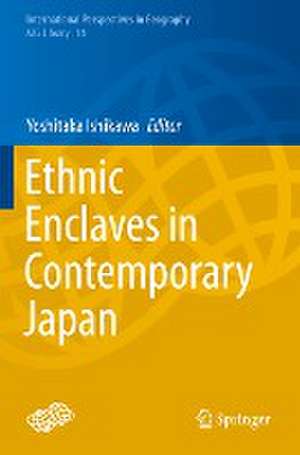Ethnic Enclaves in Contemporary Japan: International Perspectives in Geography, cartea 14
Editat de Yoshitaka Ishikawaen Limba Engleză Paperback – 3 apr 2022
| Toate formatele și edițiile | Preț | Express |
|---|---|---|
| Paperback (1) | 551.82 lei 38-44 zile | |
| Springer Nature Singapore – 3 apr 2022 | 551.82 lei 38-44 zile | |
| Hardback (1) | 729.53 lei 3-5 săpt. | |
| Springer Nature Singapore – 2 apr 2021 | 729.53 lei 3-5 săpt. |
Din seria International Perspectives in Geography
- 24%
 Preț: 729.72 lei
Preț: 729.72 lei - 18%
 Preț: 719.28 lei
Preț: 719.28 lei - 20%
 Preț: 555.18 lei
Preț: 555.18 lei - 24%
 Preț: 738.56 lei
Preț: 738.56 lei - 18%
 Preț: 784.79 lei
Preț: 784.79 lei - 18%
 Preț: 727.18 lei
Preț: 727.18 lei - 18%
 Preț: 1010.03 lei
Preț: 1010.03 lei - 18%
 Preț: 727.97 lei
Preț: 727.97 lei - 18%
 Preț: 892.59 lei
Preț: 892.59 lei - 24%
 Preț: 774.88 lei
Preț: 774.88 lei - 24%
 Preț: 724.66 lei
Preț: 724.66 lei - 15%
 Preț: 701.59 lei
Preț: 701.59 lei - 18%
 Preț: 938.83 lei
Preț: 938.83 lei - 18%
 Preț: 885.47 lei
Preț: 885.47 lei - 18%
 Preț: 943.73 lei
Preț: 943.73 lei - 15%
 Preț: 644.95 lei
Preț: 644.95 lei - 15%
 Preț: 644.95 lei
Preț: 644.95 lei - 15%
 Preț: 640.24 lei
Preț: 640.24 lei - 15%
 Preț: 649.06 lei
Preț: 649.06 lei - 15%
 Preț: 642.51 lei
Preț: 642.51 lei
Preț: 551.82 lei
Preț vechi: 689.77 lei
-20% Nou
Puncte Express: 828
Preț estimativ în valută:
105.60€ • 114.67$ • 88.71£
105.60€ • 114.67$ • 88.71£
Carte tipărită la comandă
Livrare economică 18-24 aprilie
Preluare comenzi: 021 569.72.76
Specificații
ISBN-13: 9789813369979
ISBN-10: 9813369973
Pagini: 189
Ilustrații: XV, 189 p. 64 illus., 57 illus. in color.
Dimensiuni: 155 x 235 mm
Ediția:1st ed. 2021
Editura: Springer Nature Singapore
Colecția Springer
Seria International Perspectives in Geography
Locul publicării:Singapore, Singapore
ISBN-10: 9813369973
Pagini: 189
Ilustrații: XV, 189 p. 64 illus., 57 illus. in color.
Dimensiuni: 155 x 235 mm
Ediția:1st ed. 2021
Editura: Springer Nature Singapore
Colecția Springer
Seria International Perspectives in Geography
Locul publicării:Singapore, Singapore
Cuprins
Introduction.- Overview of Ethnic Enclaves as Example Cases.- Chinese Enclaves: Formation of New Chinatowns by Chinese Newcomers.- The Contrasting Enclaves between Korean Oldcomers and Newcomers.- Filipino Enclaves as Products of Migration Industry: Cases in a Big City’s Downtown and a Port City’s Coastal Area.- Brazilian Residents as Persistent Repeaters and Their Enclaves.- Turkish Residents and Marital Assimilation.- Conclusion.
Notă biografică
Yoshitaka Ishikawa is a professor in the Faculty of Economics, Teikyo University, and an emeritus professor of Kyoto University. He received his D.Litt. in geography from the Graduate School of Letters, Kyoto University, in 1994. His main interests until about 2000 revolved around internal migration and the related temporal changes, as well as modeling spatial interactions such as migration. Since the beginning of the new century, his chief concern has been international migration and non-Japanese residents such as ethnic minorities. In more recent years, he has been keenly interested in the population decline of Japan and possible solutions to this problem. He is a leading Japanese population geographer who has contributed to international geography by publishing many books and papers on such research topics as internal/international migration and non-native residents. He served as an editorial board member of the journal Population, Space and Place (formerly the International Journalof Population Geography) for 20 years from 1995 and as the secretary-general of the International Geographical Union (IGU) Commission on Global Change and Human Mobility for 12 years from 2000. He won the IGU Lauréat d’honneur for the year 2020.
Textul de pe ultima copertă
This book is the first work to comprehensively investigate the enclaves of non-Japanese residents in Japan. In a comparative study, it convincingly examines eight enclaves of five nationalities (Chinese, Korean, Filipino, Brazilian and Turkish) in twelve municipalities. Japan now leads in terms of depopulation in countries affiliated with the Organisation for Economic Co-operation and Development (OECD). The fact that the country has been supplementing the decreased number of Japanese nationals with an increase in migrants, who form enclaves, has attracted great attention. The temporal development and status quo of such enclaves are important concerns of researchers, policymakers and the general public. This publication is the result of joint studies by geographers and sociologists and contributes to a more detailed understanding of these topics. It thus represents a valuable achievement in the study of the segregation and enclave formation of minority nationalities. The empirical validity of existing explanatory frameworks, such as spatial assimilation and heterolocalism, is also discussed in a Japanese context.
Caracteristici
Is the first comprehensive study of ethnic enclaves in Japan Includes abundant maps and tables to allow readers to compare eight sample enclaves more easily Is based on 2015 census microdata and presents detailed investigation at a neighbourhood scale in cities
